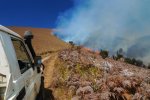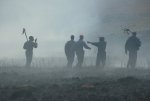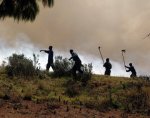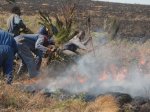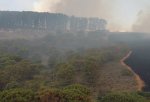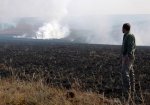By no means an expert and no direct experience in the UK but in a past life, I found myself responsible for fire control on a large chunk of remote but environmentally sensitive African bush.
The regime there was to ensure that each part of the Park (about twice the size of the Brecon Beacons), was subjected to a controlled burn once every three years to ensure that the build up of dry combustible material was minimised. Controlled burns took place at the start of the dry season at a point where the bush would burn with a little encouragement using a witches brew of diesel and petrol but it was not so hot, dry and windy that things would get out of control - at least that is the theory.
Before the controlled burn, gangs of labourers would clear fire breaks around economically and ecologically sensitive areas and where appropriate do limited controlled burns to increase the protection.
Then the fun started - a patchwork of areas fitting in with the plan of work done in previous years were ignited using special “watering cans” containing the fuel and the resulting fire was monitored and where necessary beaten to keep it under control until it burnt itself out against a fire break or some natural feature. The expression “controlled burn” is a relative term and it can look quite dramatic and when the fire brigade consists of very brave local labourers most of whom are barefoot or wearing just flip flops and the equipment is just basic fire beaters or tree branches it does feel like it is being done on a wing and a prayer.
View attachment 52571
View attachment 52581
View attachment 52576
Once the preparations had been done, it was just a case of sitting back and waiting until the height of the dry season when the dryness, heat and strong winds will mean that any fires would be much more intense spread like - well you know!

The source of the fires could be lightning strikes, poachers (the re-growth of green shoots after a fire attracts wildlife) or just accidents. It was quite stressful constantly scanning the horizon for smoke, and then deciding if where and when to try to tackle it.
View attachment 52582
View attachment 52573
View attachment 52578 View attachment 52583 View attachment 52579
The worst fire was caused by a slightly confused old lady crossing the Park In a bus or lorry who got off and lit a small fire by the roadside to cook a maize cob - within half an hour the fire was bigger than a football pitch and we were still damping down three weeks later. We stopped the fire with a backburn less than 50 metres from a very expensive wooden safari lodge. For a few hours I really regretted not getting the request not to do a controlled burn around it earlier in the year (because the charred ground would look unsightly) from the people responsible for it confirmed in writing!
View attachment 52580
View attachment 52577
An exhilarating experience which we got through with no loss of life or limb but not one I would ever want to repeat in such a remote location with no back up and only the medical supplies I carried in the back of my Landy. However, the consensus from those who claimed to know about these things was that everything had been a great success, the wild fires that had happened were much less intense due to work done in previous years and that the regeneration and expansion of ecologically important forest areas was continuing.
Controlled burning is not without its critics but the counter argument is that, at least in an African context, is that bushfires will occur anyway and by intervening and choosing the time of the burn, the intensity of the fires is reduced and the damage reduced.
The rapid regeneration after a fire suggests that most plant species are adapted to the cycle of fires, but watching vultures and storks picking through a still smoking landscape looking for a cooked meal is a bit apocalyptic.
I’m sure that nature in the UK can cope with wildfires although damage caused by fires which gets down into centuries old layers of peat is not going to be repaired quickly.




